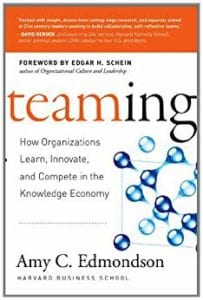
I’m so glad you joined us because we have Dr. Amy Edmondson and Greg Williams. Amy Edmondson is a Novartis Professor of Leadership and Management at the Harvard and she’s got a new book it’s called The Fearless Organization. Greg Williams is a master negotiator. He’s a Body Language Expert at The Master Negotiator. We’re going to talk to these two about some of the important leadership principles that we talk about on the show a lot. It’s a fascinating look at culture and curiosity and body language reading.
Listen to the podcast here
Teaming Versus Teams with Amy Edmondson
I am here with Amy Edmondson who is a Novartis Professor of Leadership and Management at the Harvard and she’s been ranked by a biannual Thinkers50 global list of top management thinkers since 2011. She’s written so many wonderful books about teams and innovation and her latest book is The Fearless Organization: Creating Psychological Safety in the Workplace for Learning, Innovation, and Growth. I’m excited to have you here. Welcome, Amy.
Thanks for having me, Diane. I am delighted to be here.
What led you to do this TED Talk at this point? Was this a tie-in because of your book coming out?

Teaming: How Organizations Learn, Innovate, and Compete in the Knowledge Economy
This was a tie-in from a prior book on Teaming. I had done a psychological safety TEDx Talk. They wanted me to do a TED Talk, but they wouldn’t let me do psychological safety again which is the subject of my new book because I’ve done it in a TEDx format. I had to do something else. The Teaming is something that I care a lot about and particularly teaming to innovate and accomplish amazing things, so I was pleased to do it.
You do talk about teaming versus teams a lot and some people get confused. Do you want to share?
A team is a group of people that are interdependent in achieving some shared outcome. The most important part of that definition is the group. You know if you’re part of the team or not. You’re either on the team or you’re not on the team and it tends to be clearly delineated membership whereas teaming is collaboration and coordination. They get important things done but without the luxury of stable membership so it’s teamwork on the fly. It’s people having to work with people that they might not have worked with before and that they might not even work with again. We come together, we swarm, we do something and off we go. It would not be a preferable way to operate. It’s a way of working but more and more people are having to do simply because of the nature of the work with 24/7 global operations and lots of challenging work which can’t be planned in the event. Teaming is more and more with us and it’s hard to do so I wanted to talk about how to do it well. Of course, a key piece of that is how do you create the climate? How do you create an environment where people are willing to jump in and take the interpersonal risks of teaming?
You bring up a great story in your TED Talk and I had a story that I brought up in my writing about how things come about from unusual situations. You talk about the Chilean miners being rescued and how they had to come together and never doing this before. No one knows how to do it. That’s a big challenge. That’s happening more and more now in the business world. With all these silos now and all the talk about that and then teams changing all the time now teaming with people you don’t even know, that alone can be a degree over Harvard. It’s such a huge problem for people. Can you share a little bit about the Chilean miners’ story?
As you alluded to, it was a stunningly hard problem. We had 33 men stuck 2,000 feet below some of the hardest rock in the world. In the mining industry and the copper mining industry, there was no known drilling technology capable of penetrating rock that hard and that deep fast enough to save their lives. They had been trapped after this massive collapse. They found their way to a small refuge that had approximately enough food for two men to be kept reasonably well-fed for ten days and they were 33 of them. That’s not even close to enough and the problem is unsolvable. To make a long story short, what it took was innovating in such a way that ideas from different industries from oil recovery, from NASA, from logistics, from special forces and Navy were brought together. People came together and generated ideas and tested them. Of course, most things failed but they learned fast and kept going and made it happen.
[bctt tweet=”Teaming is not a preferable way to operate, but it’s a way of working simply because of the nature of the work with 24/7 global operations.” username=””]It would not have been possible that people not been willing and able to take the interpersonal risks of learning, offering ideas, confronting mistakes and failures in a thoughtful and productive way. It took 70 days but they were able to reach them through a small incision big enough to supply food and medicine but not big enough to get people out. They were able to make that small incision happen within seventeen days. First of all, it was a stunning discovery that they were all alive still and having to solve that really hard technical problem that they then were able to buy a little more time by being able to feed them and communicate with them. They then had to solve a stunningly difficult problem of how do we devise a system to get them out and make a big enough hole to get them out through?
It’s an interesting picture to see how they got them out with that tube and what they created. They’re dealing with a situation that lives depend on it. In the working world, you’ve got so few people engaged in some issues with interpersonal skills, soft skills. I wrote my dissertation on emotional intelligence, so I’m very interested in all that same issues that these teams are dealing with. They’re not dealing with their problems in the working world as if lives depend on it. How do we get people to work as if they are working that way?
That is the leadership question. If you are a leader of people in any context, part of your job is to help people see why it matters that they do the work that they do. You cannot mount a genuine case for why it matters, for why people should be not only willing but excited about jumping out of bed in the morning to come to participate in some journey that’s larger than myself. You should step out of the way and let someone else jump in because it’s quite literally because you don’t have an obvious life or death, “The miners are going to die if we don’t solve this problem.” In some way that makes it more obvious and more compelling. That’s quite the job of the leaders to make the work compelling so that people are willing to exert themselves, come up with ideas and share them and put their heart and soul into it.
You bring up some important points not only in your TED Talk but in your book. You talk about what good does it do with talent if no one is able to speak their mind. That’s what I was trying to get in with my research on curiosity was what’s holding people back? If leaders don’t recognize that they’re not going to be innovative unless they let people ask questions and provide content, what do you think is the way to get leaders to help and be able to speak their minds? What can they do? Are there steps they can take?

Body Language: Teaming is collaboration and coordination to get important things done without the luxury of stable membership; it’s teamwork on the fly.
It starts with their own helping leaders to recognize to be mindful of what we’re up against. Many managers have a taken for granted mental model. I don’t think very much about it. It’s just my mental model but there’s work to be done and people won’t do it unless they’re motivated to do it. They should be a little bit afraid of what will happen if they don’t do it. They should be a little bit rewarded of carrot and stick but it’s otherwise straightforward. It’s like, “What do I need to do to get people to work hard?” is the question they’re asking rather than, “What do I need to do to get people to work smart and thoughtfully? How do I help people bring their great ideas and their full selves to work? How do I foster ingenuity, creativity, learning, innovation?” Those things do not happen in a fear-based culture. They simply don’t. Neuroscience research has shown us that when people are afraid, they have fewer cognitive resources available for such things as short-term memory and for creativity.
We know that fear doesn’t work for the work most of us have to do now but then we don’t we forget. Managers forget to take that seriously and think, “What’s the nature of the work we’re going to do? How do I have to show up to help people do that well?” It starts with reminding themselves of the VUCA world that we live in. The volatile uncertain complex ambiguous world. We need people asking questions and offering ideas and acknowledging failures rather than just buckle down and work hard because that won’t get you anywhere. It starts with their own recognition of the nature of the work and then their willingness to remind other people of the nature of the work. Make the logical case for the voice for why their input is both needed and expected.
You said mindfulness of what’s going on and that’s what we need. We need to get a baseline of where we are and where we need to go. There’s some groupthink out there even if you do brainstorm there are pressure especially if the leader surrounds himself with yes men. You’re getting the same answers over and over again. How do you know if you’re a leader and you’re doing that if you’re limiting yourself? You talk about psychological safety and high performance. I’m curious what you research for your book in that respect.
The fact is that silence doesn’t announce itself. You don’t know when people are holding back because there’s no thought bubble above their head that you can see. What does that mean? What are the implications of that? The implications are you’ve got to be asking. It’s the power of a good question. You’re constantly reminding yourself that your job is to be curious and if your job is to be curious, then you better ask questions. You better ask good question meaning the kind of questions that you genuinely recognize you don’t have the answer for. The kind of questions that help people focus thoughtfully on a particular situation or issue. They’re not questions like, “What’s on your mind?” They’re questions like, “What do you think about this project?” What are the risks here with this topic? They’re focusing us enough. They’re not yes or no question. They’re not overly narrow. They don’t give us a multiple-choice response. A good question helps us focus and gives us room to respond. A good question expresses curiosity and it also engenders curiosity in others.
[bctt tweet=”If you are a leader of people in any context, part of your job is to help people see why it matters that they do the work that they do.” username=””]When you’re talking about developing curiosity, I found four things holding people back. Fear, assumptions, technology and environment and a lot of those things can either overlap you. You can have fear of technology, your environment, you’d be fearful of your boss and the environment but there are so many different things that interact. I like how you said you have to always be asking. It’s almost like in sales where you’ll always be closing. We have to make it feel safe for people to ask questions. What I was trying to do when I was measuring was so people can recognize what it is that’s holding them back. I don’t think a lot of people even recognize that it might be their environment. They may have seen fear or technology, some of these things to some extent. Maybe it’s not even in your current job or your current leader but somebody else’s shut you down in the past and you just aren’t going to go through it. It’s such an interesting thing to get people to look outside of what they already know. I gave an example of the hospital that brought in Formula 1 racecar pit crew to help them be more efficient. Are they going outside of their silos, but should they be going out to other companies in other areas for ideas and inspiration?
Yes, I think so. You would think Formula 1 racecar immediately suggested danger. It seems such a very strange thing but when well done, it’s not dangerous because the risk is well managed. I’ve got a Harvard Business Review article called Wicked Problem Solvers. It’s full of stories of people crossing industry domains to get new ideas, get inspired, figure out tough problems by teaming up with people who have very different mindsets and experiences. What can we learn from a Formula 1 racecar driver that will help us promote patient safety in a hospital? It’s that kind of question. If you think further about what’s it going to take to do that, you readily recognize that it is going to require a willingness and an openness to talk to each. You’re going to need psychological safety. You’re going to need people to speak up.
When you’re talking about teams and speaking up in different things, you’re going to have a mixture of people on teams but then you’ve got extroverts overwhelming the introverts. You’ve got different personality types conflicting especially if it’s something quick coming together and teaming situations. Is there a magical way to make this be a shorter time that people can learn to work together more quickly?

Body Language: We need people asking questions, offering ideas, and acknowledging failures rather than just buckle down and work hard because that won’t get you anywhere.
I don’t have any magic wand. I keep wishing I had a magic wand. There are some nuggets. I’ve been thinking that the magical way to accelerate this process is to have people systematically and quickly answer three questions either in dyads or in a larger group. The three questions are what are you trying to get done? What’s your hope here? What’s your goal for this encounter? The second question is what’s in the way? What concerns, worries, barriers, do you see? The third question is what do you bring? What resources, talent, skills and experiences do you bring? Those questions come in increasing vulnerability. It’s a little easier to tell you my goal than it is to tell you my worry than it is to tell you what strengths I think I bring. We move up that vulnerability ladder together. When you ask people three minutes on these and then ask them what that was like, nearly everyone report that there was a sense of connection. There was a sense of recognition. I’m interested to hear what you are hoping and trying to do. More importantly, there’s a little connection that gets built, a little effective connection.
We’re going to need a lot more of that. Artificial intelligence coming to move a lot of jobs. People are going to be moving around quite a bit. You write a lot about innovation so I’m curious what you foresee with all that going on. Where are people going to go?
This is something that I feel a need to team up with other people who have a better line of sight on what’s coming at us technologically. I am in early conversations with people. There are so many wonderful tools out there and I don’t have the expertise myself. There are ways in which these tools can help us get up to speed and help us lower risks of misunderstanding rather than the other way around.
That’s why I think what you’re writing about is so important. The tool of letting people speak their minds and getting that knowledge to find out where they belong is important. A lot of people probably are mismatched to their jobs, to begin with. They just have done what they’ve always done. They don’t know anything better than that. If we’re talking to people and we’re finding out what they like and what they’re capable of doing or what didn’t work to get promoted to do because no one ever asked them, what you’re writing about is so important. It’s not just the psychological safety of it, it’s opening up a world for people where they can do something they care about. Don’t you think that’s the key to engagement?
Think about the qualitative experience of feeling engaged versus not. It’s the difference between a high quality of life and one that is, “I’m just going through the motions either at work or at home,” or God forbid both. “I don’t feel human. I don’t feel used.” We all want to be put to a good use. We want our talents and our time to be well used in service of something larger than ourselves. When that’s happening, there’s nothing better.
[bctt tweet=”The job of a leader is to make the work compelling so that people are willing to exert themselves and put their heart and soul into it.” username=””]I’m curious about what you cover in your classes at Harvard. Is it all innovation in teams or do you go in other directions?
I do a lot of education teaching and then that’s been more about innovation, leadership and teams, teaming and psychological safety. I teach an MBA course called Becoming a General Manager, which is a course about managing the messiness of organizational life. You hit a certain level in your career where you get to above the functional perspective and are more required to take on the organizational perspective. The decisions are less likely to be technical decisions and more likely to be complex. People, human, messy decisions without right answers, that’s a tough transition. It’s about making that transition. In the course, we have a module on decision making under uncertainty with different points of view and high stakes. We have a module on how you use processes and incentives to increase the chances that good things happen. It’s that general management perspective that we try to explore in a variety of ways.

Body Language: We all want to be put to a good use. We want our talents and our time to be well used in service of something larger than ourselves.
It’s all good critical thinking skills. I was looking at your background. All of your degrees, you’re an undergrad, you’re grad, you had PhD at Harvard. You must like it there.
I didn’t have ten years after graduating from college and before going to graduate school. I did have a ten-year work experience window. The Master’s degree strictly speaking comes along the way. I didn’t go back for a Master’s and then say, “This is fun. Let’s stay.” I went back for the PhD and along the way when you finished your qualifying paper and all the various tests then you’re automatically granted a Master’s. It’s not a redundant as it sounds.
I’m curious what your dissertation was in?
My dissertation was the Group and Organizational Influences on Team Learning. It was the piece of research in which I originally tested the existence of psychological safety whether it varied across groups in the same organization. If so, whether it predicted learning behavior and performance in teams, the answer to all of those questions was yes.
[bctt tweet=”When people are afraid, they have fewer cognitive resources available for such things as short-term memory and creativity.” username=””]Your work is inspiring. I loved your TED Talk. Your book is amazing and a lot of people are going to want to know how they can find out more about you. Is there any way you can share how they could do that?
The new book, The Fearless Organization, is a great way to get up to speed. Full of stories and cases and real organizations, why this stuff matters, how I learned about it and how you can create it. You can go to HBS.edu, which is the Harvard Business School website then search for Amy Edmondson and you’ll find on that faculty page lots of other information about articles, case studies, and books that I’ve written.
Thank you so much for being on the show, Amy. I enjoyed our conversation.
Thank you, so did I. It was great to be with you.
You’re welcome.
Body Language Secrets Revealed with Greg Williams
I am here with Greg Williams who’s an accomplished author, speaker, trainer and recognized worldwide for his knowledge and insights on negotiation and reading body language. It’s so nice to have you here Greg.
Thank you, Diane. It’s nice to be here.
We know each other. We’re the C-Suite Adviser Group in other areas. We have a lot in common because you write and speak and do a lot of things that involve emotional intelligence. Since I researched emotional intelligence for my dissertation, we have that. I was looking forward to this so, welcome.
Thank you.
What I find interesting is everybody knows something a little bit different even though a lot of us do some of the same things. That makes it fascinating. You are obviously a negotiating guy. Your tagline is, “You’re always negotiating.” What do you mean by that?
[bctt tweet=”A good question helps us focus and gives us room to respond. A good question expresses curiosity and it also engenders curiosity in others.” username=””]My moniker is The Master Negotiator and Body Language Expert and the tagline of, “You’re always negotiating,” came from my mother. What it means is everything that you do is a negotiation. You and I are talking right now and we’re negotiating even though the vast majority of people would not recognize it as such. Whatever you and I engage in will help to formulate a later relationship that you and I are developing now. What you see of me, hear of me, what you know of me, will be compared to what you will know later. Therefore, you’ll assess to what degree I can add value to any environment that you’re in. Thus, you’re always negotiating.
You don’t realize with communication how much of it you’re working towards some goal of some sort. That’s what she’s saying. I know you’ve written about a lot of that. You have a new book and I want to discuss that, but I also want to talk about what you write about in general. How did you get interested in body language?
When I was a little boy, I used to say to my mother, “You’re always asking people to discount something, asking them for a better deal, people will start thinking that we’re poor.” She said, “Number one, we are. Number two, the more money you save, the more money you’ll have.” That is how she also came to tell me about you’re always negotiating. I understood that as I grew older and through my years. I was a Fox News contributor at one particular point in time and because there are a lot of aspects contained in observing someone’s body language to discern exactly any hidden meaning that they’re not disclosing, I have learned a lot about reading body language. Fox News granted me the body language expert. I thought to myself, “I know a whole lot about reading body language because I have studied it intensely. They called me so I guess I might as well adopt it.”
It’s interesting because they made shows about it. They’re fun to watch. Are they accurate?

Body Language Secrets to Win More Negotiations
Some are and of course, when you’re talking about TV movies, there are poetic licenses that are employed from time to time to enhance whatever point that’s being made. To a great degree, a lot of those shows, episodes were truly depicted of what the body will do in certain situations. Let me think of that because book number six that I wrote is titled Body Language Secrets to Win More Negotiations. In that book, I talk about some of the signals. For example, if you watch someone and they’re talking, and they say something along the lines, “I really appreciate you,” while they have their palms held up mostly outward, that’s a contradiction between the body language and the word. Anytime there’s a contradiction between the words that someone is uttering and their body language, observe the body language.
Our body tries to compensate for anything that doesn’t feel right to it. When we are telling stories that are exactly truthful, we will do something with our body to try and keep our body in the state of comfort. That’s what our body always seeks, a state of comfort. Not until it’s outside of that comfort zone will it exhibit the status of a display to indicate that I don’t feel comfortable right now. I’m trying to get back into that state of comfort which is why you’ll see people rubbing the palms of their hands together sometimes, touching their face, or something of that nature. They’re trying to calm themselves.
Can you just be cold if you have your arms crossed? How do you know if somebody is closed off?
You’re always reading what’s known as a cluster of signals. Someone could be cold for a moment and may have their arms crossed though it usually exhibits some other forms to display that they’re cold. For example, if they’re shivery. You can assume that my arms are crossed because I’m cold. If they cross their arms and have not had their arms crossed and you ask them something and all of a sudden, they cross their arms, they’re literally trying to protect them. They could be trying to protect themselves. The other cluster is that you would look for what caused them to cross their arm? Remember I said the body tries to stay in a state of comfort at all times. If you asked something that caused them to try and protect themselves, the crossing of the arms would be one way that they would do so. What else might they do? They might go away from you for a period of time whereby prior to that they had not been going out in a way with the same frequency. You look at those cluster of signals. Maybe all of a sudden, they may change the pace of their speech.
[bctt tweet=”Our body tries to compensate for anything that doesn’t feel right to it because it always seeks a state of comfort.” username=””]They’re giving you clues as to something is not right. It behooves you and here’s where good negotiations come in to play. It behooves you even as a negotiator to understand what just happened. Why did the person will act the way they did? Are they not being as truthful as they should be or would want to be? Are they not disclosing something that they don’t want you to know about? As a good negotiator, you might just put it aside for a moment and come back later to test that. Those are some of the ways you can validate why someone did something with their body and to what degree their action may be trying to conceal something.
Your negotiation and emotional intelligence have all made you one of the most influential people in New Jersey, which is pretty impressive. Not only were you on Fox but you’ve been on a lot of other major networks where you are showcased. A lot of people do consulting and speaking. It’s tough to get on all the major networks like that. Other than Fox you were on ABC and some of the others. Also, you worked with Fortune 100 companies, Hollywood film producers, government entities, and the list goes on and on. Give me a little background on how you reach that level.

Negotiating with a Bully: Take Charge and Turn the Tables on People Trying To Push You Around
First of all, I’m a giving person and I say that not to be trite or anything. I grew up in a very poor environment and I constantly saw my mother and my father giving to others at times. When we didn’t have what we needed for ourselves, but they felt as though whoever it was that they gave to they did it even more than we did. It was something that was instilled in me. By giving insights to others and helping people which is my true desire, I have had the reciprocation of these opportunities coming back. Writing seven books helped also because even in my book, Negotiating with a Bully, in the turbulent times that we find ourselves in the United States, that’s gotten a lot of attention and garnered a lot more opportunities for me. Let’s say the friction that’s going on in the political environment around the United States but in other parts of the world. I get calls from people in other countries to actually speak about the topic of reading body language. I was involved in politics also having run for political office in the State of New Jersey years ago. I’ve been in positions where I’ve been able to give back to others. I was all once cynical point at a time thirteen different boards and running my own business at the same time.
All of that helped garner additional attention for me over the years. Being able to read body language and talk about negotiation strategies is a unique skill set that a lot of corporations recognize as being beneficial to enhance their bottom line. High net-worth individuals do the same thing. I negotiate sometimes on behalf of corporate clients and high net-worth individuals. You mentioned the Hollywood producers and movie makers, etc. I came into that genre as a result of helping folks oversee that wanted to get into the movie-making business in Hollywood. Extending my assistance and insights outwardly has allowed me to gain more inward opportunities.
Have they tried to get you to be a movie actor?
I have been in one movie and I’m going to be in another one.
[bctt tweet=”Being able to read body language is a unique skill set that a lot of corporations recognize as being beneficial to enhance your bottom line.” username=””]What movie were you in already?
The title of it is Impact and it’s a documentary about how individuals can change their lives. My segment is how they could do so by being able to read body language.
I know you’ve written Negotiate: Afraid, ‘Know’ More type of books so it gets me into because I’m curious. This one with the Bully, it’s very timely because of what you said. Do you address social media bullying and all that in it or is it more in negotiations? Can you give me a little more about the book?
It’s talking about how bullies react in the different environment. For example, in social media someone that has bullying tendencies can be more predominant because they have a bigger stage to hide behind. I also discuss how it is that bullying comes about in some corporations. The top always leads in any environment. In Corporate America, you happen to be in an environment that the top management or upper management says, “The only way we can get ahead is if we step on one another and we crush each other,” referring to the opposition. That then gets instilled inside of the corporate culture of that environment and people will start doing the same thing. Truth be known I worked many years ago in an environment where the owner and president of that business would have those of us that were employees competing against one another. He felt as though that would strengthen us. In reality, what it did was cause people to start proverbially stabbing one another in the back to get ahead of each other in the business side of the coin. You have to be very mindful of the culture that you create. I talk about all of that in the book even to the degree of kids in school. What does being raised in different environments create for you as far as why you might turn out to be a bully or not?
When I was a kid, I was very skinny. The older kids would beat me up from time to time and take my money. I could not fight so I learned to run back then. As I got older, I then started building my body up. I could have used the tactics that others had employed to get me when I was a kid and project those same tactics on those that I felt were weaker than me. Instead, I chose to give them the difference of understanding and teach them how they could see more self-worth within themselves as opposed to denigrating them. I chose that particular course of action simply because it probably stems from the way I saw my mother and my father interact with folks and those around me. Thus, that was my route.
I grew up with people that were in the same apartment that I was in as a kid and they took the bullying route instead. I talk about in the book what it is that you need to do to not only address the situation if you find yourself in a state of being perceived as a bully as to why you are in that state. What’s your state of mind that causes you to be like that? In addition, I also talk about how it is that bullies react in different environments as to why they act in a particular way in that environment. Are they trying to show off for somebody else? Are they trying to gain favor simply because they want to be perceived as being a tough guy? If you know what it is that’s motivating them, you then at least have a way to create a plan of how you’re going to deal with that person.

Body Language: If you know what it is that’s motivating a person, you then at least have a way to create a plan of how you’re going to deal with them.
That’s insightful because you touched on a couple of things. You chose empathy and you can put yourself in their position, which is a big part of emotional intelligence. What you’re talking about also ties into what I write about in my book on Curiosity. The things that keep people from doing things at work because they don’t want to ask questions, they don’t want to propose solutions, because they have fear. They have past experience maybe at work or somewhere else that their environment has a big impact. I found that fear, their assumptions, technology, and the environment are the four things that impacted their curiosity and you’re touching on a lot of that when you’re mentioning the culture of what organizations have. They don’t always realize that there is this culture that has caused this negative reaction.
I like that you talk about analysis because if you know what’s impacting you then you can create a plan. I love that you do that with your book because a lot of books get told that this is the way it should be, or this is that analysis of something but they don’t tell you how to fix it. They don’t tell you the next step and how to plan. Everybody is hiding behind technology to some extent and it is easier to bully. Are you seeing any differences in generations? Do you think that Generation Z is getting any less mean and nasty behind their computer than other generations? Is it getting better or is it getting worse?
It’s getting worse because they are being desensitized to what the norms were as we were growing up. Technology has moved us into space as it were with the younger generations whereby, they can hide behind the computer. Number one, be completely anonymous as far as what it is that they’ll do. Put up false profiles to project an image of something or someone that they are not because they want to create this image to attract this, that or the other. They’ve become desensitized to what the truth does mean and the value of it from time to time. Even when it comes to violence. I don’t want to get political or anything of that nature. I mentioned that leadership comes from the top. If you are in an environment politically speaking where someone has bullied their way into power and/or maintained power through bullying tactics, you then have to wonder as a society about the direction that we’re headed then. To what degree will it take to combat the bullying tactics? I’m not being specific about speaking of any individual in particular but that’s my disclaimer.
I have had interesting guests on my show, James Strock, in politics. He would like to see new ways instead of having such polarized teams where we maybe have a one-party type of thing. I don’t know what we’re going to see as far as that goes but what you’re talking about is such a challenge. I teach for multiple universities still and I see a lot of difficulty with communication with students sometimes. We try to teach tone and we try to teach a lot of the stuff that you talk about, but you don’t see body language in a virtual environment. Unless they do the synchronous type of camera type situation, which a lot of them don’t. Have you ever worked with trying to discuss how you read somebody? Do you have to deal with that at all with virtual companies that had virtual training? Do you deal with helping them read their language even if it’s not physical body language?
[bctt tweet=”Understand and teach those weaker than you to see more self-worth within themselves as opposed to denigrating them.” username=””]The answer is yes because everyone emits nonverbal signals. They do it in their writings. Most people are familiar with the all caps environment. That’s symbolic of someone screaming but you can take note of how someone writes and engages with you via social media, via any other form like email as an example. You can all of a sudden see a change in their writing style. For example, if I were to say to you on one particular day, “Diane, it is so nice to be in the environment that you’re in because we always have fun when we’re in those environments. I hope you have a lovely day today.” That day let’s say five. On day three, I write you an email, “Things are hectic today. Catch up with you later.”
I guess my news as that example is at the same time there are other examples like that that you could pick up in writing styles of people. Someone may say, “This is the best deal that I can offer.” Then, later on, they may say,” We’ve decided we can’t offer a better deal.” The switch from I to we gives you insight and to the fact that at least this person wants you to think there are others involved in this as opposed to the person initially positioning themselves to say, “I’m in charge.” Those are the type of nuances that you look for and the writing style. There are times when I’ll put a smiley face at the end of my writings and it’s saying something along the lines of, “Hope you have a nice day. Smiley face,” which adds extra emphasis. If I’m negotiating with someone in writing and I wish to change the tone, I just may omit the smiley face. That’s a small little step that gives an indication that I’m starting to move in another direction.

Body Language: Everyone emits nonverbal signals; they do it in their writings.
I know a lot of people don’t like using smiley faces, but I like to use them with my students because sometimes you type a lot of different things and they could be interpreted differently. There’s no way to say the tone without doing that. I want to make sure they know I meant it with my smile on my face and not any other way. There are so many ways that we can communicate better, and I know that you write so many books. You just keep them coming out. It was fun talking about all this with you and a lot of people will want to know how they can get your books, how they can hire you and all that. Do you have any websites you’d like to share?
People can reach out to me via the web, www.TheMasterNegotiator.com. I can be reached via email at Greg@TheMasterNegotiator.com and via phone at (609) 369-2100. Remember, you’re always negotiating.
Thank you so much, Greg.
Thank you and I reciprocate because it is fun and you’re an inspirational person. I thank you for that and the message that you spread for all of those with whom you come into contact you.
—
I like to thank Amy and Greg for such a great show. I thoroughly enjoyed having them on. If you’re interested in learning more about Cracking the Curiosity Code or the Curiosity Code Index, you can find out more at CuriosityCode.com. I hope you join us for the next episode of Take The Lead Radio.
Important Links:
- The Fearless Organization: Creating Psychological Safety in the Workplace for Learning, Innovation, and Growth
- Teaming
- Wicked Problem Solvers
- HBS.edu
- The Master Negotiator
- Body Language Secrets to Win More Negotiations
- Negotiating with a Bully
- Negotiate: Afraid, ‘Know’ More
- Cracking the Curiosity Code
- James Strock – previous episode
- www.TheMasterNegotiator.com
- Greg@TheMasterNegotiator.com
- CuriosityCode.com
About Dr. Amy Edmondson

Amy Edmondson is the Novartis Professor of Leadership and Management at the Harvard Business School, a chair established to support the study of human interactions that lead to the creation of successful enterprises that contribute to the betterment of society. She has been ranked by the bi-annual Thinkers50 global list of top management thinkers since 2011 (most recently #13). She teaches and writes on leadership, teams and organizational learning, and her books, Teaming: How Organizations Learn, Innovate and Compete in the Knowledge Economy and Teaming to Innovate (Jossey-Bass, 2012, 2103) explore teamwork in dynamic, unpredictable work environments.
Her book, Building the Future: Big Teaming for Audacious Innovation (Berrett-Koehler, 2016), reveals the challenges and opportunities of innovation that involves teaming across industry sectors. Her most recent book, The Fearless Organization: Creating Psychological Safety for Learning, Innovation, and Growth (Wiley, 2018), offers practical guidance for leaders who are serious about helping their organizations thrive in today’s challenging environment.
About Greg Williams

Greg Williams is an accomplished author/speaker/trainer and recognized worldwide for his knowledge and insights on negotiation and reading body language. He’s known as, The Master Negotiator and Body Language Expert. As a TV news contributor, Greg is often requested to appear on TV to critique the meaning and degree of truthfulness concealed in the negotiation strategies and hidden body language gestures of politicians, entertainers, and others in the news. As an author, Greg has written 7 books on the topics of negotiation, reading body language, emotional intelligence, and micro-expressions. Through his books, Webinars, consultations, and live presentations, Greg arms those seeking to enhance their skills by taking them on a journey of enlightenment. He does this by unraveling the vortex of uncertainty that some find themselves in when trying to decipher body language to add extra dimensions to their negotiation abilities.


0 Comments